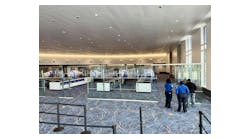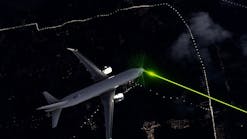Today, more people rely on their mobile phones than ever before, and this is especially true when it comes to our travel experience. In the age of the smartphone, these devices not only allow us to download boarding passes and check in for flights in advance, but also to shop, surf and catalog our travel experience on social media.
Mobile devices offer consumers more flexibility and entertainment options for their journey, but our reliance on our smartphones – and the data generated by our usage – also presents a huge opportunity to airports. It has been estimated that 90 percent of the world’s data has been created in the past two years; however, the vast majority of that data is unstructured, leaving many businesses, including airports, trying to figure out the best way to collect and analyze this data to better inform how they operate.
The technology that can help airports leverage our mobile reliance into tangible business benefit lies in beacon technology. Beacons are small wireless devices that broadcast a short-range Bluetooth signal, which is detected by an app on a mobile device as it comes in proximity to the beacon. The detection can trigger notifications, open web pages, or push advertisements directly to that mobile device. A passenger need only download an app, which most airports already have developed.
Though it may seem trivial, the reality is anything but. Here are four ways that this technology can benefit both airports and travelers alike:
- Real-time Updates and Navigation: Airports can use beacon technology in conjunction with mobile apps to deliver real-time “day of travel” information directly to passengers in the airport, be it a gate change or flight delay. For passengers connecting to another flight, beacons can help the airport communicate directions straight to the traveler’s smartphone. As a traveler arrives at his connecting airport terminal, the beacon would be pinged by the app on his phone, and the airport could instantly send him the details and directions to his next flight, bypassing a crowded information kiosk.
- Generating Non-Aeronautical Revenues: Beacons can also help promote dining and retail – a priority for many airports in growing their non-aeronautical revenue. If a travelers arrives in a terminal 90 minutes before his connecting flight, the beacon there could send him information on nearby dining options, along with a coupon for 10 percent off his meal at the new high-end restaurant in the terminal. Data generated by beacons can also help airports and their retailers gauge how they’re performing. For example, if a beacon in one end of terminal 1 is pinged 10 times more than the beacon at the other end of the terminal, the airport or retailers see the problem in real-time and can try to incentivize traffic to the slower shops via promotions or discounts sent to their phones.
- Passenger Flow Management: Beacons also generate information about passengers, airlines, and baggage that can be key to effectively planning service capacity, resources, and staffing. For example, if an airport sees a high volume of travelers ping a beacon around security checkpoint 3, with a relatively low volume of people pinging the beacon at checkpoint 1, resources can be diverted to either move passengers to the less crowded security line or provide additional staff at the busy location. This not only creates a more harmonious experience for the airport and the traveler, but the data can also be used to generate predictive models that can allow the airport to better plan for and allocate resources where they are needed most, before there is an urgent need to do so.
- Improved Operational Efficiency: In addition to passenger data, beacons can also help airports track their own employees. If an airport or airline experiences a problem near one of their gates, the airport can check and see which employees ping the beacon near where the problem is. This allows for a faster and more efficient response to problems as they arise. Additionally, beacons can help detect if any employee or individual tries to access an area that they are not supposed to, which can help ensure proper airport security.
As for the security of the beacons themselves, most beacons come with different security features – many of which are customizable. Depending on the application in which you use your beacons, there are several ways to ensure that the data being generated is kept secure.
In the age of the connected traveler, being able to directly engage with customers where they are already playing can be a major differentiator for any airport or airline. Not only do beacons generate analytics that can provide airports with an opportunity to improve the experience they offer to their travelers, but the data generated can help airports bolster their own efficiency, organization, and most importantly, their profitability.
Dheeraj Kohli is Vice President and the Global Head of Travel and Transportation for Blue Bell-based Unisys Corporation. He can be reached at [email protected].





